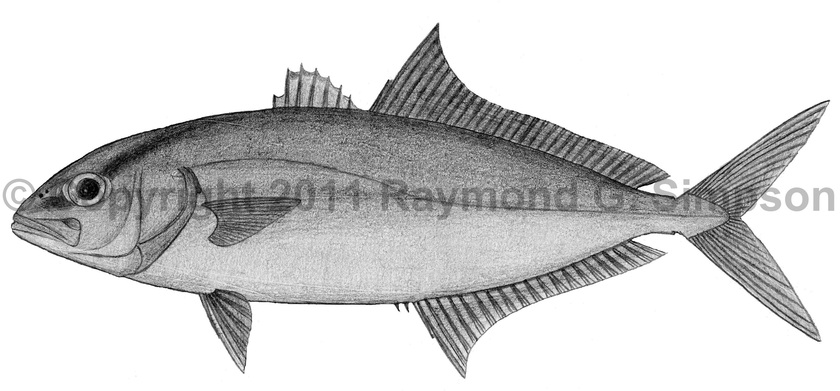
Common Name
Greater Amberjack
Year Described
Risso, 1810
Identification
Dorsal Fin: 7 spines (last reduced in larger fish), followed by I, 29-34
Anal Fin: 2 spines (reduced and embedded in large fish), followed by I, 18-22
Pelvic Fin: I, 5
Gill Rakers: 5-6 upper, 15-16 lower; 18-24 total in fish <20cm, 11-19 total in fish >20cm
Vertebrae: 10 precaudal, 14 caudal
Elongate and moderately shallow bodied. Jaw extends to around middle of eye. Supramaxilla broad but rounded posteriorly (acute angle in S. rivoliana). Teeth minute and present in both jaws. Spiny first dorsal much lower than second dorsal. Second dorsal base 1.4-1.7 times longer than anal fin base. Second dorsal and anal fin have raised anterior lobes with dorsal lobe contained 6.7-8.1 times in FL. Pelvic fins larger than pectoral fin. Lateral line with a shallow anterior arch and a straight posterior portion with no scutes. Caudal peduncle grooves present. Body smooth with tiny cycloid scales. First anal pterygiophore curved in fish >10cm.
Color
Bluish, gray, or olive above, grading to white below. A dark bar often passes through eye to dorsal fin base and an lateral amber stripe is often present from eye to tail. Dorsal fin dusky. Caudal fin dark with a pale posterior margin. Anal fin dusky to yellowish with a pale base and tip to lobe. Pelvic fin dark with light anterior margin. Juveniles pale with 5 dark body bands and a sixth on the caudal peduncle. Fins clear with no bands.
Size
Common to 110cm. Maximum size to 188cm.
Habitat
Pelagic and demersal. Adults from 18-72m, occasionally deeper, in open water or over soft bottoms. Junveniles found near the surface and often associate with flotsam.
Range
Nova Scotia to Brazil, including the Caribbean islands and Bermuda.
References
Smith-Vaniz, W.F. 2003. Carangidae (pp 1426-1468). In: Carpenter. 2003. The living marine resources of the Western Central Atlantic v. 3.